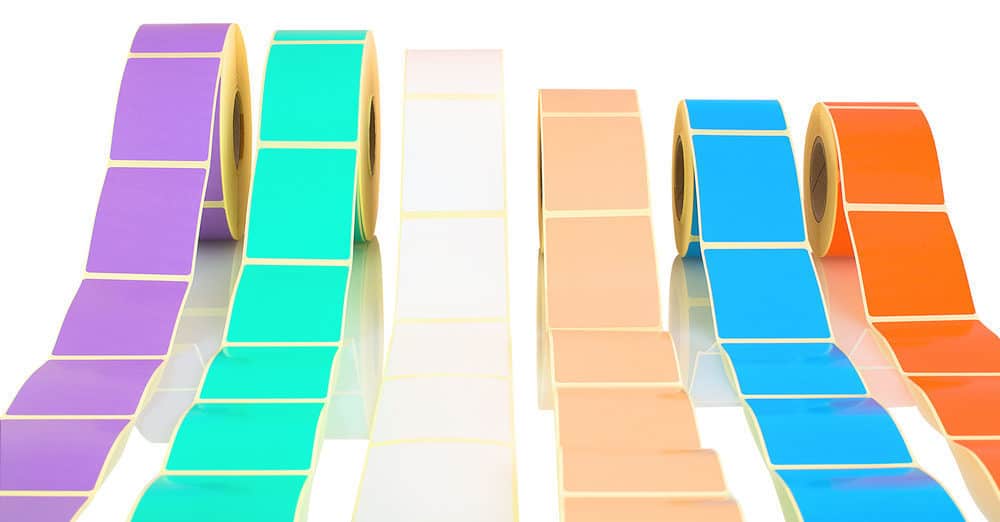This post may contain affiliate links, which means that we get commissions for purchases made through such links, at no additional cost to you. As an Amazon Associate we earn from qualifying purchases.
Welcome to this article where we talk about thermal transfer papers. You will learn about thermal transfer papers, how they work, and what you can use them for. This article is comprehensive and contains all the details you need on thermal transfer papers.
What is a thermal transfer paper? Thermal transfer paper is the type of thermal label used for thermal transfer printing. It is less expensive than direct thermal labels, which are used for direct thermal printing, but they require ribbons for printing. The thermal printhead heats and melts the ribbon pigments and transfers it to the paper to create imprints.
Thermal transfer papers are typically tougher and more durable than direct thermals. They also hold up to direct sunlight and heat better than direct thermal papers. And because of how the papers work, thermal transfer printheads last longer than direct thermal printheads.

Are There Different Types of Thermal Transfer Papers?
“Thermal transfer paper” doesn’t have different types. But it is sometimes used as a compound term to refer to all thermal transfer labels, including paper and synthetic media. But then, you can differentiate paper materials by the kind of surface coating. There are two types of surface coatings, namely gloss and matte coatings.
The type of thermal transfer label you will use depends on your specific application. But of all types, semi-gloss thermal transfer paper is used the most because its applications are wide-ranging. They also produce clear and legible prints. You can use them for carton and warehouse labeling, as well as food and product labeling.
What is Synthetic Thermal Transfer Label?
Synthetic labels also exist for thermal transfer printing. Different varieties of synthetic label materials include polyethylene, vinyl, and polypropylene. They also come in clear transparent forms, as well as various colors.
Synthetic thermal transfer labels are generally more durable than paper labels because they are waterproof, scratch-proof, and resistant to the elements. They are the choice options for applications that require longer-lasting and more durable labels.
How Do Thermal Transfer Papers Work?
Thermal transfer papers work with ribbons to create images. When you feed thermal transfer paper rolls into a thermal transfer printer, you must also place ribbon rolls in the printer. As both the paper and ribbon pass over the thermal printhead, the printhead emits heat onto the ribbon. The heated ribbon melts onto the paper and cools immediately to create a lasting imprint.
The main component of the thermal printer is the thermal printhead. This printhead has tiny pins that get hot when the printer is running. These hot pins come in direct contact with thermal ribbons, which contain solid ink pigments. The pigment melts and transfers to the paper, thus creating an image.
How Are Specific Images Formed?
A microprocessor controls the thermal transfer printhead and determines how the heating pins are activated. The heating pins activated as the ribbon and paper pass over the printhead determine where images will form on the paper.
The pins rapidly heat and cool as each one touches the ribbon so that the image will be exact. This makes thermal transfer prints crisp and clear; suitable for printing long-lasting labels and high-density barcodes.
Uses of Thermal Transfer Papers
Labels printed with thermal transfer papers can hold up to harsh environments. They are used for applications that will be exposed to sunlight and abrasion. Common thermal transfer paper uses include the following:
- Stock usage
- Product identification
- File tracking
- Sample labeling
- Shelf storage
- Asset tracking
- Certification labeling
- Permanent identification
- Inventory identification
- Lab specimen labeling
- Freezer labeling
- Cold storage
- Outdoor application
Do Thermal Papers Require Ribbons?
Thermal papers require ribbons. These ribbons are polyester films with different layers of coating. The ribbon’s ink layer melts when the thermal printhead delivers heat to it and transfers it to the label. This ink layer is usually made of wax, resin, or a combination of both.
All thermal ribbons are not created equal. Pure resin ribbon is the best quality of ribbon available while the wax ribbon is the least quality. Wax/resin ribbons combine both materials and have an intermediate quality.
The Different Ribbon Types
Below are the 3 main thermal transfer ribbon types based on ink materials and their different uses:
Wax Ribbon
Wax ribbons are generally suitable for printing on paper labels. You must keep wax-printed labels dry, away from water, chemicals, oils, and other elements that can cause abrasions. High levels of heat can also melt wax ink away. But if you protect the label by laminating it or adding a layer of varnish to it, their imprints can last for many years.
Wax/Resin Ribbon
Wax/resin compounds are suitable for both smooth and coated thermal transfer labels. This combination will give you a better image than wax ribbons, but they are also more expensive. They are also more durable than wax ribbon but you must still guard them against abrasion and excessive moisture.
Pure Resin Ribbon
Resin ribbon is the most durable and toughest material you can use on your thermal transfer label. This ribbon is not suitable for paper media. Their inks do not just stick to label surfaces, but they sink fuse onto synthetic labels and sink in to create incredibly durable prints. You should consider resin ribbons for industrial, marine, hazardous chemicals, automotive, and aircraft applications.
The final output of the different ribbon types might not look distinct to the naked eyes, but they differ in strength and durability. You should know the measure of strength and durability that your application requires before you decide on the ribbon type to use. And make sure that you match the ribbon with the appropriate print media.
How Should You Combine Thermal Ribbons and Labels?
Various combinations of ribbon and label cater to different label applications. But for extreme conditions and exposure to the elements, resin ribbon and synthetic media is the best combination. This combination is the most durable and lasts the longest.
The combination of synthetic media with pure resin ribbon makes labels that can withstand very harsh environments. These labels won’t fade under direct sunlight and you can even immerse them in water. Some synthetic materials are also resistant to chemical and oil damage.
✅ Video – How does a thermal transfer printer work?
HellermannTyton believes that talk without demonstration is ineffective. That’s why this video contains both description and demonstration. What do you want to know about thermal transfers? You will find all the basic info in this short video. From printer to labels to ribbons, you will learn all you need to know about thermal transfer printing.
Related Questions
What Is Direct Thermal Paper?
Direct thermal paper is the specialty paper used for direct thermal printing. Direct thermals are special because they do not require ink for printing. They contain ink pigments in a layer of heat-sensitive chemicals. When the direct thermal printhead heats these papers, heat activates the ink pigments and the image forms on the paper.
Direct thermal papers are quite expensive but they are still affordable. They offer a cheap solution for short-term applications. You can use them for applications, such as receipts, tags, and tickets.
What Is A Heat Transfer Paper?
Heat transfer papers are specialty papers that can transfer print designs from their surfaces to garments under heat application. The first step in this process is to print your design on the heat transfer paper sheet with a laser or an inkjet printer. You will then, place the paper on the garment and apply heat to transfer the design.
The heat transfer mechanism is different from the thermal transfer mechanism. While the thermal transfer mechanism uses thermal printers, the heat transfer mechanism uses laser and inkjet printers. Thermal transfer is used to make labels while heat transfer is used to customize garments.
Do Thermal Transfer Ribbons Expire?
Thermal transfer ribbons often have an expiry date. Manufacturers place an expiry date of between one to two years on their thermal transfer ribbons. Generally, you can safely store thermal ribbons for about 2 years. After that, they are likely to dry out and become unusable.
Conclusion
Thermal transfer papers have become game-changers for many businesses across diverse industries. They make clear prints for various applications, and they are durable too. For the best output, make sure to combine thermal labels with the appropriate ribbon type. There’s so much to learn about thermal transfer papers and thermal transfer printing in general. And we believe this guide has taught you a lot already.
